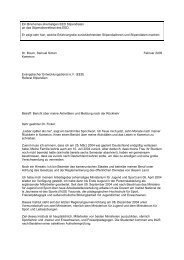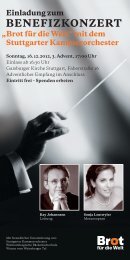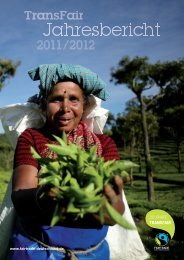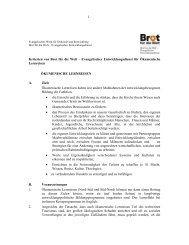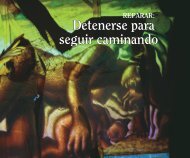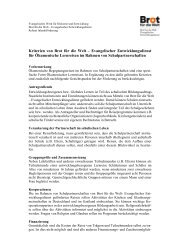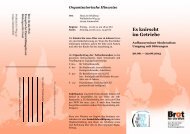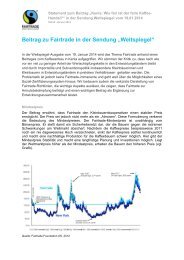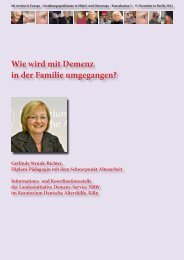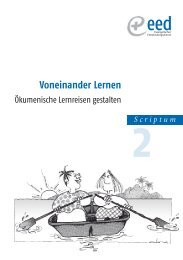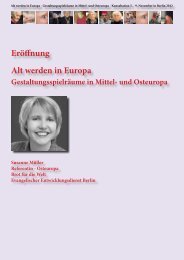Bread for the World & ACT Alliance Discussion ... - Brot für die Welt
Bread for the World & ACT Alliance Discussion ... - Brot für die Welt
Bread for the World & ACT Alliance Discussion ... - Brot für die Welt
- No tags were found...
You also want an ePaper? Increase the reach of your titles
YUMPU automatically turns print PDFs into web optimized ePapers that Google loves.
Both examples also clearly indicate that people affected suffer from severe violations of fundamental human<br />
rights (i.e. <strong>the</strong> rights to life, health, water, and food, as well as housing, land and property rights) leading to<br />
humanitarian catastrophe and displacement while <strong>the</strong> States breach <strong>the</strong>ir obligations under international<br />
human rights law (e.g. International Covenant on Economic, Social, and Cultural Rights) to provide a<br />
maximum of available resources to protect and fulfill <strong>the</strong> victims’ rights.<br />
We encourage States to establish an international Mechanism to address loss and<br />
damage, fulfilling at least three key functions<br />
Considering <strong>the</strong> responsibility of <strong>the</strong> community of States to act co-operatively to end such severe threats to<br />
human security and to prevent o<strong>the</strong>r such incidences to happen, whe<strong>the</strong>r caused by slow onset events (e.g. sea<br />
level rise) or caused by sudden onset events (e.g. cyclones, droughts, floods), <strong>Bread</strong> <strong>for</strong> <strong>the</strong> <strong>World</strong> and <strong>ACT</strong><br />
welcome <strong>the</strong> decision at COP 18 “to establish, at COP19, institutional arrangements, such as an international<br />
Mechanism to address loss and damage.”<br />
<strong>Bread</strong> <strong>for</strong> <strong>the</strong> <strong>World</strong> and <strong>ACT</strong> call on States in general and on Germany and <strong>the</strong> European Union in particular<br />
to pro-actively work towards <strong>the</strong> creation of such an international Mechanism and an integrated multiple<br />
functional approach, consisting out of<br />
(i) risk assessment, reduction and preparedness<br />
(ii)<br />
(iii)<br />
economic risk compensation and insurance<br />
and <strong>the</strong> set up of rules and guiding principles, including implementation Mechanisms, to deal with<br />
residual economic and non-economic losses, including rehabilitation.<br />
inspired by a co-operative spirit of solidarity, in line with common but differentiated responsibilities and<br />
respective capabilities, and in full coherence with <strong>the</strong>ir respective States’ obligations under international law,<br />
in particular human rights law.<br />
Most vulnerable people should be precisely identified and prioritized by a new<br />
Mechanism<br />
In order to fully understand loss and damage 2 , and in compliance with international human rights law, States<br />
have to precisely identify vulnerable people’s needs in developing countries, being affected or threatened by<br />
loss and damage. Hereafter and in order to reduce loss and damage 3 , <strong>the</strong>se people have to be prioritized by<br />
any action related to <strong>the</strong> reduction, compensation or management of loss and damage.<br />
Financing <strong>for</strong> loss and damage could fall within <strong>the</strong> USD 100 billion commitment<br />
The establishment of an international Mechanism requires new approaches on finance. Para 8 of <strong>the</strong> Doha<br />
decision on loss and damage reads as follows: “(…)requests developed country Parties to provide developing<br />
country Parties with finance, technology and capacity-building, in accordance with decision 1/CP.16 and o<strong>the</strong>r<br />
relevant decisions of <strong>the</strong> Conference of <strong>the</strong> Parties.” 4 Fur<strong>the</strong>r to this, <strong>the</strong> Doha decision on <strong>the</strong> agreed outcome<br />
of <strong>the</strong> AWG-LCA reaffirms “...that developed country Parties commit, in <strong>the</strong> context of meaningful mitigation<br />
actions and transparency on implementation, to a goal of mobilizing jointly USD 100 billion per year by 2020<br />
to address <strong>the</strong> needs of developing country Parties” (preamble to finance section). Accordingly it could be<br />
argued that financing <strong>for</strong> loss and damage, <strong>for</strong> <strong>the</strong> time being, does not come on top but falls within <strong>the</strong> USD<br />
100 billion commitment of developed countries. Accordingly, <strong>Bread</strong> <strong>for</strong> <strong>the</strong> <strong>World</strong> and <strong>ACT</strong> call on States to<br />
consider <strong>the</strong> creation of <strong>the</strong> necessary financial arrangements to respond to loss and damage under <strong>the</strong> Green<br />
Climate Fund, by creating an own Loss and Damage Fund, or by any o<strong>the</strong>r adequate, effective and efficient<br />
instruments.<br />
Residual loss and damage cannot be dealt by adequately under adaptation<br />
2 FCCC/AWGLCA/2010/l.7 Para 28<br />
3 -/CP.16, AWGLCA Para 25<br />
4 Decision 1/CP.16 locks in <strong>the</strong> Copenhagen financing fast start commitments of USD 30 billion <strong>for</strong> <strong>the</strong> period 2010–2012<br />
(paragraph 95) and USD 100 billion per year by 2020 (paragraph 98)<br />
2



